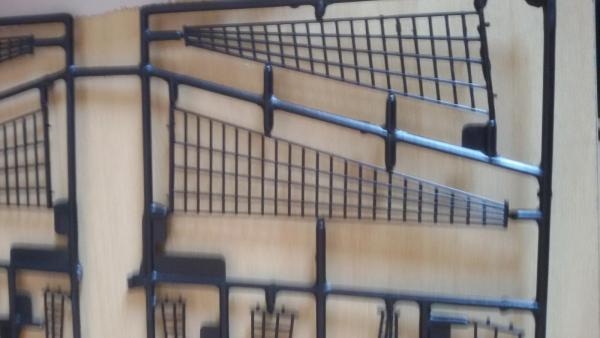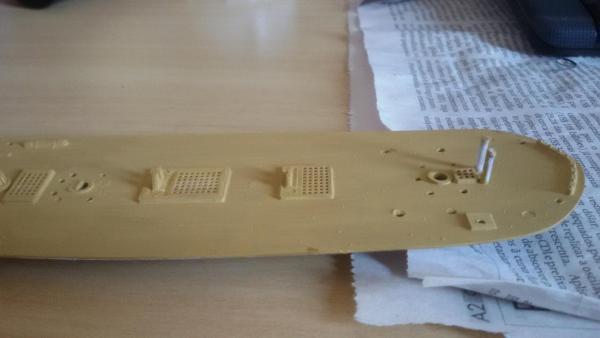-
Posts
95 -
Joined
-
Last visited
Content Type
Profiles
Forums
Gallery
Events
Posts posted by Ray1981
-
-
Hey Duffer,
I hope you didnt read my thread as a complain it is not a complain something i noticed while making this boat. Because it is my second kit im building im trying to experiment with techniques and see how i could do certain things the best. I try to make the kit as real as I can do ans surely have fun.
I posted this question to see what others thik about kits and their quality, just curiosity. And find out what would be a nice kit to built in the future so thank you for your repsonse.
I saw here pictures on the forum from the Heller's Santa Maria which looks very nice.
Regarding modifications you mentioned there is one thing i like to try out in this kit and that is making those nets which you see on the side of ship by myself I dont know the real name so I post a picture.
Grtz Ray
-
Hello all,
I started yesterday on my second project the HMS Bounty from Revell. I notced a couple of things on this model that aint realy realistic IMHO. Im not a very experienced builder and really new to this hobby. And I dont want to downgrade Revell with its quality in this thread but the kit contains a lot of plastic thats not part of the kit and needs to be sanded or cut away (thats not a big issue). But regarding detail when i look to the deck of the ship it shows me planks but there no slots between the planks rather its the opposite. I hope you guys understand what im talking about, I have attached a foto.
So my question is what is a good brand in plastic ship models. Ive seen on the market a couple of brands like Airfix, Heller, Revell etc. I was hoping poeple would like to tell me who is making really good and detailed plastic models?
Thanks in advance
Grtz Ray
-
-
A wash means, as the word indicates, a layer of diluted paint that does not fully cover the underlying layer of paint. Essentially it is a technique already used by the the Old Masters to create a feeling of depth in their oil paintings. It can by used in painting with acrylics too. You basically dilute the paint with water until it contains only a little pigment. How much dilution is difficult to describe, one has to experiment with. I sometimes use acrylics that are maint for airbrushing and apply these just with a brush. Normally paint to be applied with a brush has to be thicker, so the airbrush paints have a good consistency for 'washing'. An effect of 'washing' is also that the pigment accumulates in surface depressions (such as engraved lines) or in corners, which is or can be an intended effect: these areas are less worn and, therefore, accumulate more patina or dirt, so that they appear darker (assuming that one used a darker colour for the wash).
The 'washing' procedure can be repeated, once a previous layer is dry, which happens quite fast with acrylics. If you don't wait until the previous layer is dry, you may just wipe it off, when you go over the area again.
'Washing' does not work, when the solvent in the paint easily dissolves underlying layers of paint. So one has to be cautious when using organic solvent-based paints, such as enamels.
Many people use (artists) oil-paint washes over acrylics. Because their pigment is very finely ground, they make good washes. When using oil-paints, one has to wait until they have dried, before applying the next layer of wash, which can be a long-winded process. Though, oil-paints are based on using organic solvents, the drying process in reality is an oxidation process, so that they are not easily re-dissolved by applying the next wash.
I am also using inks (which by definition usually do not contain pigments, but dyes, i.e. organic coloured compounds), but if these inks are not 'permanent', i.e. water proof after drying, each wash needs to be protected by light layer of varnish, applied either by airbrush or with a spray can. Sepia ink makes for a good wash.
I hope this explained the procedure a bit.
wefalck
Hello all,
These are some gret posts but im a bit overwhelmed with all these techniques. I will start soon with painting the deck of my HMS Bount from Revell. Theye wrote I should use the colour Sand Matt nr 16 (maybe the gurus know this colour by head). But when I look on pictures this is not the real effect im looking for. I think im looking more for the efect as Welfack shows on his pictures. Ok I understand im new and will not be able to make it as Welfack has done but I like to make an attempt.
Im using enamel paint from Revell as mentioned before I beleive/hope that with this paint this is possible as well. I looked also a bit further and saw some colours from Testors and I think Testors no 1120 would be a good first layer and than apply this dry brush technique with color with 1141 (light wood) this together with some white. But as I said im really new to this and im affraid to start with it and destroy my kit right away. Could anybody tell me if this is a good starting point or does it makes no sense what I described before.
I hope someone can help me a bit.
Are different brands of paint interchangeble?
And what about those weathering powders that are on the market are those helping?
Sorry for all those rookie questions
thanks inadvance
Ray
-
Hi Ray,
Check out the following thread on painting. It should have some good tips.
http://www.modelshipworld.com/index.php/topic/3962-how-to-make-plastic-look-like-wood
(Sorry if it doesn't link direct. I'm on my phone and it won't let me hyperlink)
Thank cwboland I went thru this thread before i posted my question but as far I could understand they all speak mostly about air brushing and dry brushing. Well the latter i dont know what it is and a air brush system i dont have.
p.s. your link worked perfect.
-
Hi All,
This is my first big question here im just new to the forum and this hobby. In a couple of days I will start with my first plastic kit from Revell the HMS Bounty. Because im new I did not bought straight away an air brush system.
So I'm wondering how can I paint with brushes on plastic and make it look like wood and a bit warned out wood. I saw some pictures online of the model i bought and some look very very good and the ones that have been painted as the instruction manual says looks like it is all new.
I bought all the colours that I need according the manual but if needed I can buy some other extra colours or materials to make it a bit more authentic. Before I really start I try to investigate a bit. Im hoping there is someone who could give me some tips.
Thanks in advance
Ray






What are the best detailed plastic models?
in Plastic model kits
Posted
Thanks popeye2sea, anyonehas some recourses on how to make this by yourself appearantly im not the only one who would like to do this.